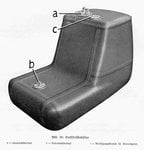FLYBOYJ
"THE GREAT GAZOO"
The only system as such I ever heard of is a portion of cooled bleed air being ducted back to the fuel tanks to keep "head pressure" on the fuel within the tanks not only ensuring a positive flow from the tanks but reducing fumes. Mind you this system is on turbine aircraft or turbo props. I did work on P2Vs very briefly and don't recall any type of fuel tank purge on that aircraft, but then again all we did was get it ready for a ferry flight.Bottled gas systems have also been used in a/c for tank inerting, regulators having been going back and forth on a rule that all airliners have this since the TWA Flight 800 disaster, apparently from an explosive atmosphere in a fuel tank and source of spark from malfunctioning deepwell pump. US carriers had similar systems, using CO2, even at the beginning of WWII.
As far as inert gasses being used in current airlines, I don't think its happening except for newer airliners. (Mind you I've been out of Heavy aircraft maintenance for about 4 years now). I do know that the C-5 and the C-17 has such as system, but some of the airliners and larger military aircraft I've worked on (DC-9, 10, B727, P-3 and C-130) did not have such a system (or at least to my memory).

